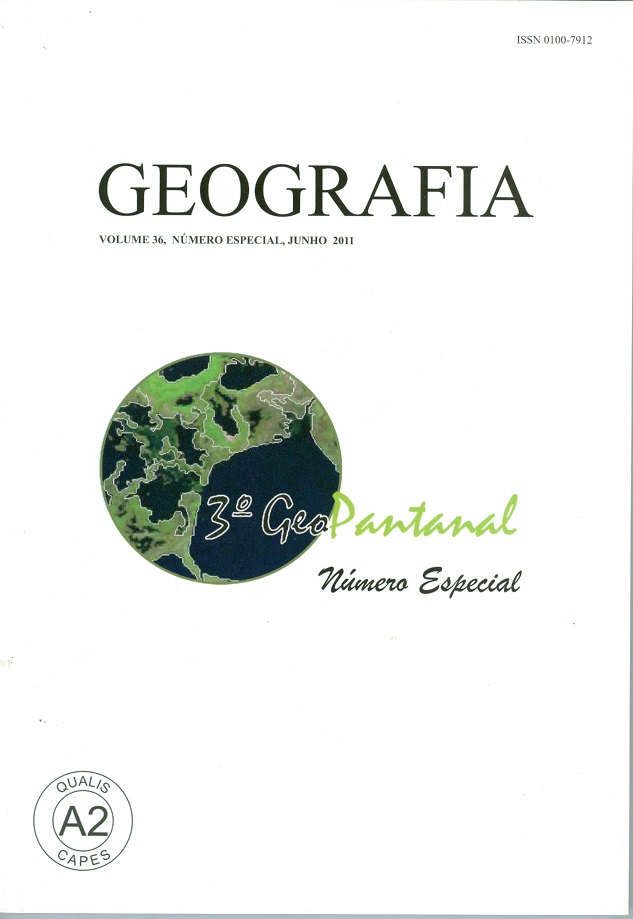APPLICATION OF FUSION TECHNIQUES TO (ETM+/SRTM) IMAGES TO RECOGNIZE AND INTERPRET DEPOSITIONAL LANDFORMS: AN EXAMPLE FROM THE NEGRO RIVER ALLUVIAL PLAIN, PANTANAL MATO-GROSSENSE
Resumen
The objective of this paper is to demonstrate the application of HSV fusion techniques of decorrelated spectral bands from Landsat 7 ETM+ with NASA SRTM data for the extraction of drainage networks and identification of depositional and erosive landforms of Negro River fluvial plain, located in the southern Pantanal, Mato Grosso do Sul State, central-west Brazil. This technique allowed a significant gain at the interpretation of landforms, as compared to interpretation carried out using only satellite images. The landforms were highlighted in the resultant merged images with SRTM data, allowing the identification of relief features poorly evident in satellite images. The images generated clearly showed the existence of erosive landforms, such as tributary streams and channels, degrading relict landscapes represented by ponds, similar to those of the Nhecolândia area that characterize the southern part of the Taquari fluvial megafan. The use of this technique helped to establish the chronological sequence of depositional and erosive events on the Negro River plain, showing that merged images can be successfully used to interpret the geomorphologic evolution of alluvial plains, and a potential tool for the interpretation of other fluvial systems in the Pantanal of Mato Grosso. Key-words: Image Fusion. SRTM. ETM sensor. Pantanal. Fluvial Systems. Aplicação de técnicas de fusão de imagens (ETM+/SRTM) no reconhecimento e interpretação de geoformas deposicionais da planície do Rio Negro, pantanal mato-grossense Este trabalho tem como objetivo mostrar a aplicação de técnicas de fusão HSV de imagens de satélite do sensor ETM+ do LANDSAT 7 com dados SRTM da NASA na extração de redes de drenagem e na identificação de geoformas deposicionais e erosivas da planície fluvial do rio Negro, situado na área sul do Pantanal Mato-Grossense. Com a aplicação da técnica utilizada, houve ganho significativo em relação à interpretação realizada unicamente com imagens de satélite, as geoformas foram ressaltadas nas imagens resultantes da fusão com dados SRTM, o que permitiu identificar feições de relevo pouco evidentes nas imagens de satélite. As imagens geradas mostraram com bastante clareza a existência de geoformas erosivas, tais como vazantes e canais tributários atuais, desfigurando paisagens relictas representadas por lagoas semelhantes às da Nhecolândia, que caracterizam a porção sul do megaleque do Taquari. A utilização da técnica contribuiu para estabelecer a sucessão de eventos deposicionais e erosivos na planície do rio Negro, mostrando que a fusão de imagens pode ser utilizada com sucesso na interpretação da evolução geomorfológica de planícies fluviais, sendo ferramenta potencial para a interpretação de outros sistemas fluviais do Pantanal Mato-Grossense. Palavras-chave: Fusão de imagens. SRTM. Sensor ETM. Sistemas Fluviais. Pantanal.Descargas
Publicado
Número
Sección
Licencia
Los autores mantienen los derechos de autor y otorgan a GEOGRAFIA el derecho de primera publicación, estando los artículos licenciados simultáneamente bajo la Licencia Creative Commons BY 4.0, que permite compartir y adaptar los artículos para cualquier propósito, siempre que se cumplan los créditos y disposiciones de derechos de imagen, privacidad. o derechos morales. Se puede acceder a otras atribuciones legales en: https://creativecommons.org/licenses/by/4.0/legalcode.en.

Geografia, Rio Claro, SP, Brasil- eISSN 1983-8700 - Licencia Creative Commons BY 4.0,





